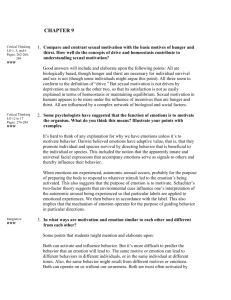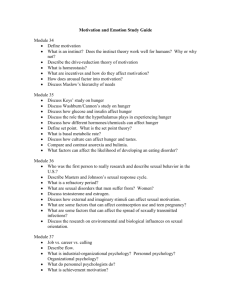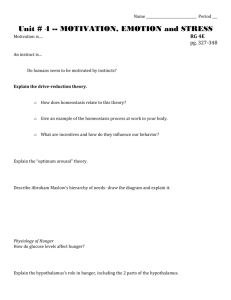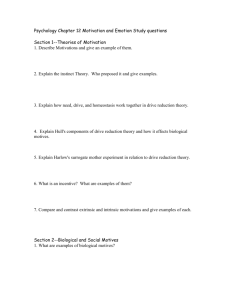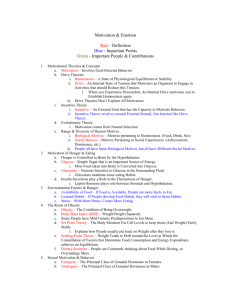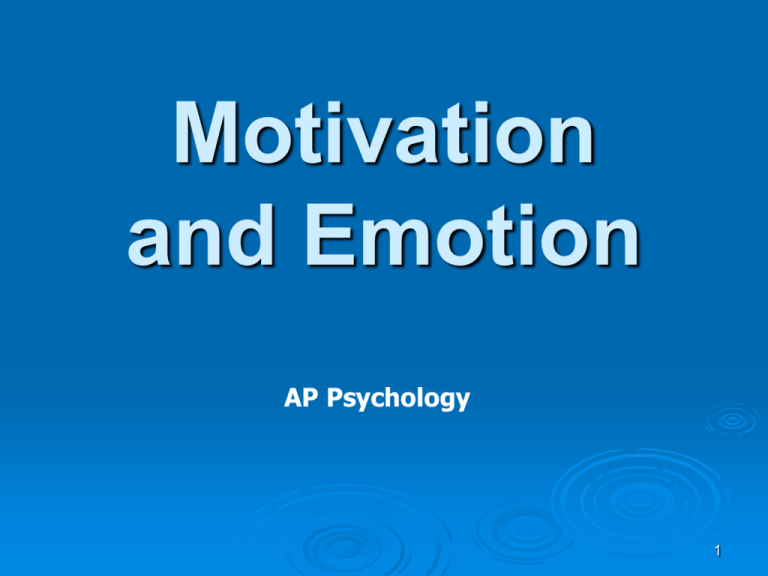
Motivation
and Emotion
AP Psychology
1
Lesson One: Theories of
Motivation
By the end of this lesson,
I will be able to…
1. Describe basic
theories of motivation.
2. Identify the difference
between instincts and
motives
3. Analyze the strengths
and weaknesses of each
motivational theory.
2
Where Do We Begin?
Motivation – a psychological process that
directs and maintains your behavior toward a
goal.
Motives are the needs, wants, interests, and
desires that propel or drive people in certain
directions.
3
Motivation and Instinct
Motivation
Most of the time is
learned – we are
motivated by different
things.
Instinct
complex behavior that
is rigidly patterned
throughout a species
and is unlearned
4
Biological and Social Motives
Biological Motives
Hunger
Thirst
Sex
Sleep
Excretory
Social Motives
Achievement
Order
Play
Autonomy
Affiliation
5
Drive Reduction Theory:
Drive-Reduction Theory
When individuals experience a need or drive, they’re motivated to
reduce that need or drive.
Drive theories assume that people are always trying to reduce internal
tension.
Therefore, drive theories believe that the source of motivation lies
within the person (not from the environment)
Need
(e.g., for
food, water)
Drive
(hunger, thirst)
Drive-reducing
behaviors
(eating, drinking)
6
Carl is stranded on a deserted island. He
spends his day looking for fresh water. His
desire to find water would be considered a:
1. Drive
2. Need
3. Want
4. Drive reduction
trait
5. Both 1 and 2
7
Motivation
A Drive is an internal state of
tension that motivates us to
engage in activities that reduce
this tension.
Our bodies strive to keep
somewhat constant.
Homeostasis
Sometimes we HAVE to
reduce the drive (dying of
thirst, hunger, etc.) – we might
not have a choice.
Incentive
These can lead us to make
choices different than what we
may normally make.
Example – Money, Power,
etc.
8
Drive Reduction Theory Tested:
Drive reduction theory
has some implications.
Have you ever eaten
when you weren’t
hungry?
What about a person that
excessively works out?
How do we account for
other motivating factors
like: achievement, power,
and curiosity?
9
Incentive Theories:
Again, an incentive has an
ability to motivate behavior.
Push vs. Pull theory –
1. Internal states of tension
push people certain directions.
2. External stimuli pull people
in certain directions.
According to incentive theory,
motivation comes from the
environment around you.
10
So… What is the difference between drive
theory and incentive theory?
Drive theory –
Biological internal
motivation
(homeostasis)
Incentive theory –
Environmental
motivation (not as
much homeostasis,
more outside factors)
11
When asked why he wants to become a doctor, Tom says, “Because
I’ve always liked biology and being a doctor will allow me to make a
good salary to take care of my family.” His answer is most consistent
with which of the following theories of motivation?
1.
2.
3.
4.
5.
Drive Reduction
Incentive
Hierarchy of
Needs
Arousal
Instinct
12
Arousal Theory:
Arousal – level of alertness,
wakefulness, and activation
caused by activity in the CNS.
The optimal level of arousal
varies with the person and the
activity.
Yerkes-Dodson Law – We
usually perform most activities
best when we are moderately
aroused.
Challenge – moderately low
level
Easy – moderately high level
The law also states that we
perform worse when arousal is
either to low or too high.
Think about sports or driving a
car
13
Maslow’s Hierarchy of Needs:
Debate
Maslow says lower needs
must be met before you can
continue up the pyramid
Do we always place out
highest priority on meeting
lower-level needs?
Examples:
1. Political activists go on
hunger strikes
2. Soldiers sacrifice their lives
3. Parents go without food in
order to feed their children
Lastly – scientific evidence
does not support Maslow’s
theory.
14
According to the Yerkes-Dodson model, when facing a
difficult challenge, which level of arousal would probably
lead to the best outcome?
1.
2.
3.
4.
5.
A very low level
A moderately low
level
A moderate level
A moderately high
level
A very high level
15
Lesson Two Objectives: Hunger, Thirst, and Eating
Disorders:
By the end of this lesson,
I will be able to:
1. Discuss the biological
factors in the regulation of
hunger and thirst.
2. Describe the
environmental factors in
the regulation of hunger.
3. Identify the difference
between anorexia and
bulimia.
16
Motivation-Hunger
Why do I feel hungry?
Glucose
the form of sugar that
circulates in the blood
provides the major
source of energy for
body tissues
Glucose Low = hunger
Glucose High = feel
full
17
Brain Regulation:
The hypothalamus
regulates several
biological needs
(including hunger and
thirst)
“Investigators found that
when they surgically
destroyed animals’ lateral
hypothalamus, the
animals showed little or
no interest in eating.”
(Anand & Brobeck, 1951)
18
Check This Out! – Cont.
“When researchers
destroyed animals’
ventromedial nucleus
of the hypothalamus,
the animals ate
excessively and
gained weight
rapidly.” (Brobeck,
Teperman, & Long,
1943)
19
Hypothalamus Theory:
This theory had
always been widely
accepted.
Now some debate
ensues
Several researchers
are focusing more on
neural circuitry than
just the
hypothalamus.
20
Hunger - Environmental Factors
There are several
environmental factors
that affect our hunger
1. Availability of food
2. Learned preference
and habits
3. Stress
21
Hunger – Cont.
Eating for survival vs.
eating for pleasure.
Tasty food is more
likely to be eaten
even when full
(palatability)
Environmental cues
matter
1. Commercials
2. Odors
3. Talking about it
22
Learned Preference and Habits
Food preferences acquired through
learning
Sugary and fatty
foods are important
for survival (that’s
why they’re popular)
23
Stress and Eating
Enjoyable foods = feeling
better
Stress = overeating
This is a vicious cycle because
the food doesn’t really make
you “feel” better.
We are born with a
predetermined number of fat
cells
When we gain weight – fat
cells increase in size / set point
goes up
When we lose weight – fat
cells decrease in size / set
point goes down
Click the pic!
24
Motivation-Hunger
Set Point
the point at which an
individual’s “weight
thermostat” is supposedly
set
when the body falls below
this weight, an increase in
hunger and a lowered
metabolic rate may act to
restore the lost weight
Basal Metabolic Rate
body’s base rate of energy
expenditure
25
Eating Disorders:
Anorexia Nervosa –
starvation, low body
weight, frequent exercise,
usually women
Bulimia Nervosa –
eating binges, followed by
vomiting or laxatives
Some theories state
social influences (media,
peers, sexual abuse, etc.)
Some theories state low
levels of serotonin =
depression
26
Thirst:
Regulation of thirst is similar to regulation of hunger.
Mouth dryness plays a role
Most important is the fluid content of cells and the
volume of blood
When we vomit, have diarrhea, or donate blood, the
volume of our blood decreases.
Our hypothalamus encourages us to drink to bring this
system back to homeostasis.
27
LS 3 – Sex and Motivation
By the end of this lesson, I will be able to:
1. Describe why sex is both a societal and
biological norm
2. Identify the concept of sexual orientation
including homosexuality, bisexuality, and
heterosexuality.
3. Briefly describe the sexual response cycle
4. Discuss some of the social issues surrounding
early sexual activity
28
Sex and Motivation:
Why do we have sex?
Testosterone =
sexual motivation
Puberty = increased
testosterone and
estrogen
Any correlation
between teen sex and
this maturation
process?
29
The Journey of Sexual Arousal: Bet
You Didn’t Know This One!
When something gets your
“sexual attention” your
Hypothalamus sends a signal
to the pituitary gland.
The Pituitary gland then
secretes two hormones
(luteinizing and follicle
stimulating)
These hormones travel to your
gonads (yes ladies you have
gonads) – testes and ovaries
Then your gonads provide you
with the sensation of arousal.
30
Sex and Society:
Sex
has always been a taboo topic
Companies spend millions of dollars a
year on advertising that includes sexual
images
Freud said that psychological disorders
stem from the repression of sexual
feelings.
31
Sex in the Media:
32
Reproduction:
Much research has been done
on the difference between
genders on choosing a partner
for reproduction:
Females – Optimize
reproductive success by being
very selective in their mating
They are more interested in
mating with an individual that
can provide adequate
resources for their child.
Males – Optimize reproductive
success by mating with many
females
They seek young, healthy, and
fertile mates
33
The Sexual Response Cycle:
Masters and Johnson were two
psychologists that researched
the physiological changes that
occur during sex.
1. The excitement stage
2. The plateau – increased
breathing, muscle tension
3. Orgasm – males/ejaculation,
females/muscle contraction
4. Resolution / Males have a
refractory period in which
achieving an erection is
difficult
34
Lesson Four: Social Motivation:
By
the end of this lesson I will be able to:
1. Describe the psychological research
behind achievement.
2. Identify the underlying factors that
motivate you to succeed.
3. Define the four types of conflict
situations and how we approach or avoid
conflict
35
Achievement:
Achievement Motive The desire to meet some
internalized standard of
excellence
High achievers want to:
1. master difficult
challenges
2. outperform others
3. meet high standards of
excellence
36
How Do You Measure
Achievement Motivation?
Thematic Apperception
Test (TAT)- Ambiguous
scenes are shown and
subject must respond to
the picture.
This reveals personal
motives and traits:
Again, as with personality
assessment, this is quite
subjective
37
Traits of People that Score Highly
on Achievement Motivation:
They tend to work harder
and more persistently on
tasks
They handle negative
feedback better
They are more likely to
delay gratification in order
to pursue long term goals
They typically go into
competitive occupations
that provide them with the
opportunity to excel.
38
Achievement: David McClelland
High Achievers –
choose moderately
challenging tasks (these
offer the most return) and
avoid easy and
impossible tasks
Low Achievers – choose
easy or impossible goals
so they don’t have to take
responsibility for failure.
39
Situational Forces and
Achievement:
Atkinson’s Theory
(1992) – The tendency to
pursue achievement in a
particular situation
depends on the following
factors:
1. The strength of one’s
motivation to achieve
success
2. One’s estimate of the
probability of success.
3. The incentive value of
success.
40
Situational Forces (cont.)
According to Atkinson:
The pursuit of
achievement increases
as the probability and
incentive value of
success go up.
Can someone put this
into laymen’s terms.
Do you agree with this?
41
Intrinsic vs. Extrinsic:
Society tends to encourage
people to be extrinsically
motivated ($$$$!!!! )
Although everyone needs
some money, why is it more
important to some and not to
others?
Intrinsic – a desire to perform
an activity for its own sake
rather than an external reward
Extrinsic – a desire to perform
an activity to obtain a reward
such as money, attention, etc.
42
Intrinsic vs. Extrinsic research:
Research shows that people
that are more intrinsically
motivated tend to be
psychologically healthier and
happier.
Over Justification Effect –
Promising a reward for doing
something you like to do
results in you seeking the
reward as the motivation for
performing the task.
This tends to diminish the
intrinsic motivation to do
something.
Example: Rewarding a child
for drawing a picture
43
Affiliation Motivation:
Affiliation Motive –The need
to be with others (friends,
family, spouse, etc.)
This motive is aroused when
people feel
1. Threatened
2. Anxious
3. Celebratory
Why does this happen?
Evolutionary Perspective:
Social bonds were/are
important for survival and
reproduction
44
What’s Next?
Social Conflict Situations:
1. Approach-Approach– 2 positive outcomes
(can only pick one)
2. Avoidance-Avoidance – 2 negative outcomes
(can only pick one)
3. Approach – Avoidance – both options have
positive and negative outcomes
4. Multiple approach – avoidance – multiple
choices, multiple outcomes.
45
Other Terms: Cont.
Selye’s
General Adaptation Syndrome:
3 stage process for the body’s reaction to
stress.
1. Alarm – sympathetic nervous system
2. Resistance – Raised body temp., heart
rate, etc.
3. Exhaustion – weak immune system
46
Lesson Five: Emotion
By the end of this lesson I will be able to:
1. Describe the basic elements of the emotional experience
2. Explain the James-Lange Theory of Emotion
3. Explain the Cannon-Bard Theory of Emotion
4. Explain the Schachter - Singer Two-Factor Theory of
emotion
5. Explain the Opponent-process theory of emotion
6. Explain the Cognitive – appraisal theory of emotion
47
We Are Emotional Creatures:
– weddings
Grief – funerals
Jealousy – ex-boyfriend/girlfriend
Rage – driving
Happiness – passing a big test
Joy
48
What IS Emotion?
Emotion involves:
1. A subjective conscious
experience (cognitive)
Accompanied by…
2. Bodily arousal
(physiological)
and
3. A characteristic overt
expression (behavioral)
Think he brushes his teeth?
49
What Causes Emotion(s)?
Neurotransmitters –
Endorphins, serotonin
Autonomic Nervous System –
Fight or flight
Endocrine system – Hormones
Amygdala – fear and anxiety
Frontal lobes – control
interpretation of emotions
Right hemisphere – handles
positive emotions
Left hemisphere – handles
negative emotions
50
The Research:
Paul Ekman – found at
least six basic facial
expressions that are
universally recognized by
people all over the world
(happy, sad, angry,etc.)
Psychologists agree that
emotions have
physiological, behavioral,
and cognitive
components
They disagree as to how
these three components
interact.
51
Cognitive Component:
This picture caption
should say: Don’t hide
your emotions.
Emotions are personal and
subjective
2 Dimensions of Emotion:
A. Arousal (intense / not
intense)
B. Positive or negative quality
Fear, disgust, sadness, and
surprise are all emotions
We have learned that certain
emotions mean certain things
(angry face and survival)
52
Physiological Component:
Emotions involve automatic
reactions that can be difficult to
control. (think how you feel
after someone cuts you off)
Emotions are always
accompanied by physical
arousal (lump in throat,
increase heart rate)
The Autonomic Nervous
System is responsible for your
fight or flight responses
So…a polygraph (lie detector
test) is really an emotion
detector – heart rate, blood
pressure, and respiration rate.
53
Behavioral Component:
Would it hurt you to smile a bit?
Emotions are expressed
in “body language” – non
verbal behavior
Facial expressions reveal
a variety of emotions
(think about really good
actors/actresses)
Facial expression tests
are widely used.
Let’s try!!!
54


